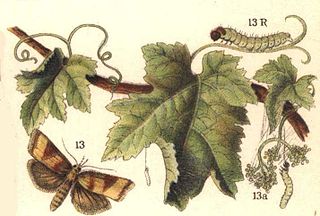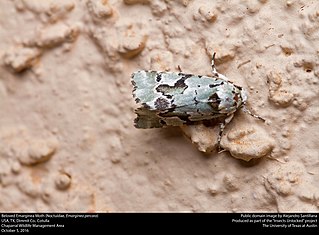
The Pterophoridae or plume moths are a family of Lepidoptera with unusually modified wings. Though they belong to the Apoditrysia like the larger moths and the butterflies, unlike these they are tiny and were formerly included among the assemblage called "microlepidoptera".

Arthur Gardiner Butler was an English entomologist, arachnologist and ornithologist. He worked at the British Museum working on the taxonomy of birds, insects, and spiders.

Coleophora is a very large genus of moths of the family Coleophoridae. It contains some 1,350 described species. The genus is represented on all continents, but the majority are found in the Nearctic and Palaearctic regions. Many authors have tried splitting the genus into numerous smaller ones, but most of these have not become widely accepted.

Gracillariidae is an important family of insects in the order Lepidoptera and the principal family of leaf miners that includes several economic, horticultural or recently invasive pest species such as the horse-chestnut leaf miner, Cameraria ohridella.
Anomoses hylecoetes is a species of primitive hepialoid moth endemic to Queensland and New South Wales, Australia . It is the only species in its genus Anomoses, which is the only genus in the family Anomosetidae.

Choreutidae, or metalmark moths, are a family of insects in the lepidopteran order whose relationships have been long disputed. It was placed previously in the superfamily Yponomeutoidea in family Glyphipterigidae and in superfamily Sesioidea. It is now considered to represent its own superfamily. The relationship of the family to the other lineages in the group "Apoditrysia" need a new assessment, especially with new molecular data.

Eupterotidae is a family of insects in the order Lepidoptera with more than 300 described species.
Eriocottidae or Old World spiny-winged moths is a family of insects in the order Lepidoptera whose position relative to other members of the superfamily Tineoidea is currently unknown. There are two subfamilies, Compsocteninae and Eriocottinae.

Epicopeiidae is a family of insects in the order Lepidoptera. They are known as oriental swallowtail moths as they closely resemble some oriental swallowtail butterflies. Epicopeiidae have highly varied structure in regards to body size and wing shape. Epicopeiidaen wing patterns are involved in complicated mimicry rings.

The Glyphipterigidae are a family of small moths commonly known as sedge moths, as the larvae of many species feed on sedges and rushes. More than 500 species have been described in the family.

The Sparganothini are a tribe of tortrix moths.

The Thyatirinae are a subfamily of the moth family Drepanidae with about 200 species described. Until recently, most classifications treated this group as a separate family called Thyatiridae.

Cuculliinae is one of the larger subfamilies of moths in the family Noctuidae.

Eudonia is a large and widespread genus in the grass moth family (Crambidae), subfamily Scopariinae. There is no common name for the roughly 250 species placed here; new species are still being described regularly. Although the genus was proposed early in the 19th century already, many of these moths were for a long time retained in Scoparia, the type genus of the subfamily and a close relative of Eudonia. A few small genera have been proposed for separation from Eudonia, but given the size of this group this is not particularly convincing; thus, all are retained here pending a comprehensive phylogenetic review.
Mattesia is a genus of parasitic alveolates of the phylum Apicomplexa. Species in this genus infect insects.

Gracillariinae are a subfamily of moths which was described by Henry Tibbats Stainton in 1854.
The Metarbelidae are a family of the Cossoidea also called the carpenter or goat moths, and is sometimes treated as a subfamily, Metarbelinae of the Cossidae. No synapomorphies are shared with the Cossidae based on adult morphology. The family Metarbelidae was first described by Embrik Strand in 1909.

The Stenomatinae are a subfamily of small moths in the family Depressariidae.
Eugene Gordon Munroe was a Canadian entomologist who discovered numerous species of insects. He worked for the Insect Systematics and Biological Control Unit, Entomology Division in Ottawa, Canada.

Psaphidini is a tribe of owlet moths in the family Noctuidae. There are at least 40 genera and at least 90 described species in Psaphidini.
















